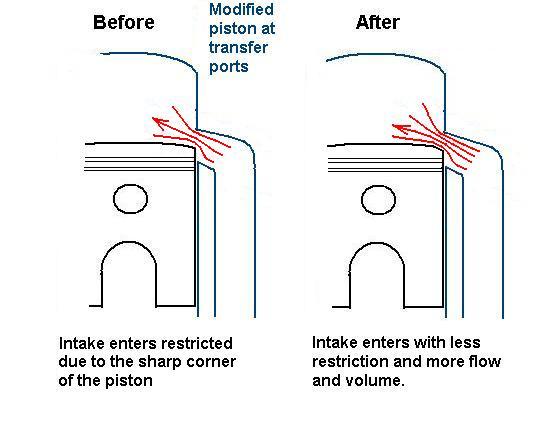|
On page 117 of "Two Stroke Tuners Handbook" Gordon Jennings wrote how one could grind transfer and exhaust port ramps into the piston crown to test porting ideas without grinding on the more expensive cylinder. He suggested it as a temporary trial for porting without mention of the aspect I would like to focus on here.  Flow Restiction in Ports  His focus was on rounding the edges of the port whereas mine is on rounding the edges of the piston top where it is adjacent to the transfer ports as a means to reduce flow restriction due to the near-90-degree edges. What I did was I ground down the piston edges (adjacent to the ports) .8mm at a 40 degree angle to horizontal. Actually I made the transition curved somewhat at the beginning and end of each "ramp". The more the edges are "in line" with the desired flow, the more efficient and less restricted that flow will be. In other words, for the same area of opening you can have more flow as if the piston had already moved farther down and out of the way. To be safe this mod should only be done when there is at least 2mm between the crown edge and the top of the piston ring. (Mine has 2.8mm)
What I did was I ground
down the piston at a 40 degree angle to horizontal
that gave the equivalent of .8mm higher at each port. And I made the transition curved somewhat at the beginning and end of the
"ramp". For the same area of opening you can have more
flow as if the piston had already moved farther down and out of the way.
Jennings had wrote that differences and inconsistencies of the transfer ports tops mostly affect just the low and mid range
power because at top rpm the time that those
inconsistencies are significant may be too short although on my latest test on a 48cc I gained 600 more RPM from 7000 to 7600. 
Latest test: On my 48cc with reed valve I couldn't climb a 8.5 degree street but by adding the ramp and putting JBWeld on the roof of the transfers I kept the transfer duration the same and was able to climb the street with power to spare. I also gained 600 RPM for 7600 maximum. My final thoughts is that this piston ramp may have the greatest effects on engines w/o a high peak rpm. Someone with a 14,000 peak rpm engine tried this and reported that he got no benefit. My engine only peaks at 7600 rpm with this mod. So any non-screamer engine with enough space on the piston to put a ramp on it can probably benefit from this mod. On my 55cc a .8mm piston ramp adds 6 degrees transfer port duration. For the same duration change a Honda 125 (with 54.5mm stroke) needs a 1.1mm ramp, and a Honda 250cc (with 72mm stroke) needs a 1.45mm ramp. Also, the longer the piston stroke (ie: larger engine), the faster the piston speed at the same rpm. I believe that the ramp effect may not be realized at high rpm but I haven't confirmed this myself. With four strokes taking over the motocross world I think the last remaining competing two strokes need every little trick in the book to be competitive again. 4 strokes main advantage is the wide powerband they have. This mod restores some width to the 2 strokes powerband. But I don't recommend a piston ramp for the exhaust since it would have the opposite effect in that it would benefit high rpm power and lessen low rpm power. At slow piston speeds the port (exhaust or transfer) would have a greater port duration. At the transfers that would benefit low rpm power by lessening the pressure at port opening. (The higher the transfers are, the less the crankcase compression ratio.) At the exhaust that would only benefit high rpm power at the expense of low rpm power. If you don't want to increase the 48cc and 66cc transfer port durations by addition of transfer ramps then just add JBWeld at the top of the transfers. The 1mm ramp by itself essentially raises the transfers 1mm and increase the duration by 9 degrees from 110 to 119 which is good if you also have a higher exhaust port than standard, which gives a broader RPM range. |